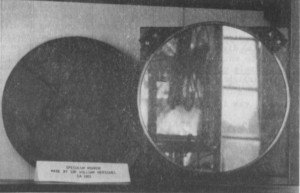Herschel 14 ft Telescope1826 (1838 – 1850’s) |
Index:
Summary; History; Current; Technical; Sources; Links; Gallery:
In brief
Important Contributions:
Description:
Around 1826 the Board of Longitude purchased from the Herschel’s (William or John?) a wooden-tube 14-Foot (4.2 meter) telescope, with a 14-inch (35.5 cm) diameter Speculum mirror and later sent it to the Cape Observatory. The first two astronomers, Fallows and Henderson, never unpacked it from its packing crate. The telescope was erected by Maclear on the wooden floor under one of the domes of the main building. Thomas Maclear apparently first used it on 1 September 1835 to study Halley’s Comet. (This was an auxiliary instrument. Other auxiliary instruments were the Dollond 3-inch and Jones 3 ½ -inch telescopes.)
Shortly before returning to England in 1838, John Herschel repolished the mirror for Maclear. The telescope did not perform well, not because of deficiencies in the telescope but because of where it was erected (see Building below).
In 1843 Smyth wanted to observe a comet and moved the telescope (probably outside the building onto solid ground) Maclear did not like it and ordered Smyth to cease observing and to return the telescope to the “telescope room”.
By 1850 at the latest, the telescope was no longer in use and eventually disappeared, the mirror only being found again in 1987. [Smits; Warner-Herschel Telescope; Warner-Astronomers. p.53, p.58.]
Historical Background
Owner/s:
Where Located:
Current Information
Present Location:
Owner:
Status:
Condition:
Technical Details
Type: Reflector
Aperture:
Focal Length: 14 ft (426.72 cm)
Mirror: 14-inch (35.56-cm) speculum mirror. Speculum consisted 5 parts tin and 12 parts copper.
Mounting:
Attachments:
Manufacturer:
Building: The main building of the Cape Observatory originally had two domes on its roof, which were later dismantled because they were impractical. The telescope proved to be a serious failure, not because of the telescope that Herschel described as having “fine light and a very good defining power”, but because no instrument piers had been provided for mounting the telescopes. Maclear’s opinion was “these domes have been foolishly placed absolutely resting on a floor, a wooden floor, over a room nearly 20 feet square belonging to a dwelling house and no Pillar, nothing but the said floor for the Instrument … The plan is ludicrously foolish, an instrument upon which such important observations depend to be placed on a boarded floor and that on the upper storey! With a violent wind.” [Copied from Warner-Astronomers, p.53.]
Sources
Link to the Main Bibliography Section and more information about Sources.
Documentation:
Pictorial Sources:
Bibliography:
- Smits, P., A Brief History of Astronomy in Southern Africa. (Unpublished)
- Warner, B., The William Herschel 14-Foot Telescope” MNASSA, Vol. 46, Nos. 11 & 12, 1987 Dec.
- Warner, B., Astronomers at the Royal Observatory Cape of Good Hope.
Links
Gallery
 14-foot William Herschel speculum mirror that was discovered under the floor of the MaClean building at the S.A.A.O. in 1987.
14-foot William Herschel speculum mirror that was discovered under the floor of the MaClean building at the S.A.A.O. in 1987.
Source: MNASSA
